DECEMBER 1, 2023
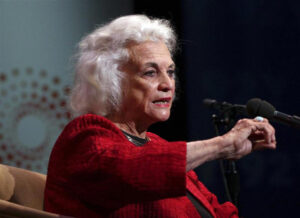
FILE PHOTO: U.S. Supreme Court Justice Sandra Day O’Connor speaks during an interview with Reuters Editor-in-Chief Stephen Adler at the 92nd Street Y in New York March 15, 2012. REUTERS/Shannon Stapleton/File Photo
WASHINGTON, D.C. – Retired Justice Sandra Day O’Connor, the first woman on the U.S. Supreme Court, whose centrist views and shrewd negotiating skills allowed her to steer the nation’s law for much of her quarter-century tenure, died on Friday at the age of 93, the court said.
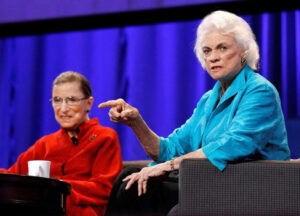
FILE PHOTO: Former Associate Justice Sandra Day O’Connor (R) speaks next to Associate Justice Ruth Bader Ginsburg during the lunch session of “The Women’s Conference 2010” in Long Beach, California October 26, 2010. REUTERS/Mario Anzuoni/File Photo
The court said in a statement that O’Connor died in Phoenix of complications related to advanced dementia and a respiratory illness.
Chief Justice John Roberts recalled O’Connor as having “blazed an historic trail as our nation’s first female justice.”
“She met that challenge with undaunted determination, indisputable ability, and engaging candor,” Roberts said. “We at the Supreme Court mourn the loss of a beloved colleague, a fiercely independent defender of the rule of law, and an eloquent advocate for civics education.”
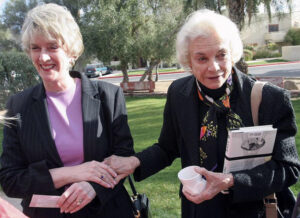
Retired U.S. Supreme Court Justice Sandra Day O’Connor (R) and Arizona Supreme Court Chief Justice Ruth McGregor greet people before O’Connor’s speech on her first day of retirement from court at the Kerr Cultural Center in Scottsdale, Arizona February 1, 2006. McGregor was O’Connor’s first law clerk when O’Connor began her term on the Supreme Court in 1981. REUTERS/Jeff Topping
O’Connor, who retired from the nation’s highest court in 2006, had in her latter years been diagnosed with dementia and announced in October 2018 that she was withdrawing from public life.
When Republican former President George W. Bush replaced the pragmatic westerner with the more ideologically rigid conservative Justice Samuel Alito, the already-conservative court moved further to the right.
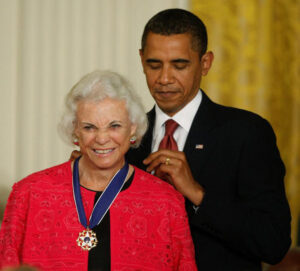
FILE PHOTO: U.S. President Barack Obama (R) presents the Medal of Freedom to the first female Supreme Court Justice, Sandra Day O’Connor, during a ceremony in the East Room of the White House in Washington, August 12, 2009. Obama presented the nation’s highest civilian honour to 16 recipients during the ceremony. REUTERS/Jason Reed/File Photo
O’Connor, who grew up on an Arizona ranch family, navigated the male-dominated world of politics in her home state and then of law in the nation’s capital. Her 1981 appointment by Republican President Ronald Reagan made her the Supreme Court’s first woman justice nearly two centuries after the Supreme Court was established in 1789 but her place in history went beyond breaking men-only barriers.
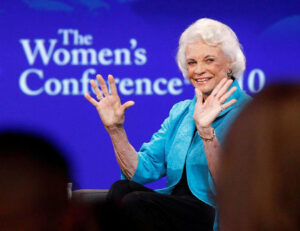
FILE PHOTO: Retired Supreme Court Justice Sandra Day O’Connor speaks during the lunch session of The Women’s Conference in Long Beach, California October 26, 2010. REUTERS/Mario Anzuoni/File Photo
Although she was conservative by nature, she became the court’s ideological center. With pragmatism and a knack for building consensus, she controlled decisions on the most contentious issues of her era, including helping preserve a woman’s right to abortion and upholding affirmative action on college campuses.
O’Connor described her tenure as similar to walking on wet cement “because every opinion you offer, you’ve left a footprint.”
With her ranch-bred work ethic and plain-spoken way, O’Connor’s mantra was “be constructive.”
Unlike any of the justices who served during her time, O’Connor had run for elective office and knew how to work a backroom and count votes. The former Republican state senator often strategized with individual justices to try to force the hands of others and reach the crucial five votes among the nine for a majority decision.
O’Connor avoided sweeping pronouncements and voted for incremental change, becoming a pivotal vote on the court in the process. Her views became more liberal with time. After expressing some ambivalence about Roe v. Wade, the 1973 decision that made abortion legal nationwide, she created a critical alliance in 1992 to affirm Roe’s central holding.
“Some of us as individuals find abortion offensive to our most basic principles or morality but that cannot control (the court’s) decision,” she wrote.
The Supreme Court, which has had a 6-3 conservative majority since 2020, overturned the landmark Roe ruling in 2022.
While O’Connor was generally suspicious of racial remedies, she was a crucial vote in 2003 to uphold campus affirmative action favoring racial minorities in admissions.
O’Connor wrote in the ruling that colleges must strive for diversity “if the dream of one nation, indivisible, is to be realized.”
The Supreme Court’s conservative majority in June struck down race-conscious admissions programs in higher education, effectively prohibiting affirmative action policies long used to increase the number of underrepresented minority students in American colleges.
O’Connor’s views on gay rights evolved, too. In 1986 she voted to uphold a Georgia law prohibiting sexual relations between homosexuals but voted in 2003 to strike down a similar law in Texas.
O’Connor was with the majority when the court ruled 5-4 on ideological lines to stop the Florida presidential vote recount, ensuring that Republican George W. Bush candidate won the presidency over Democrat Al Gore in 2000.
She later expressed regret about the ruling, telling the Chicago Tribune in 2013 that the court did not need to get involved.
LAW SCHOOL AT 19
O’Connor was born on March 26, 1930, the eldest of three children of Harry and Ada Mae Day and growing up on the family’s Lazy B ranch was a hard, lonely life. For school, she was sent to El Paso, Texas, where she lived with her maternal grandparents.
She graduated from high school at age 16, went to Stanford University and was only 19 when she started law school as one of just five women in the class. Rehnquist was a classmate and they briefly dated.
O’Connor graduated near the top of her class but was rejected for most law firm jobs. A Los Angeles-based firm offered a job as a legal secretary but she declined and eventually found work in the San Mateo County, California, county attorney’s office.
She and her husband, John, whom she met in law school, later settled in Phoenix. She was raising three sons when she became active in state politics. She was appointed to fill the unexpired term of a state senator in 1969 and then ran successfully to hold the seat.
O’Connor became Arizona Senate majority leader in 1973, the first woman in the country to lead a state senate. She was elected as a state trial judge in 1974 and in 1979 was named to a state appeals court.
O’Connor met Warren Burger, then chief justice of the United States, in 1979 through mutual friends. He was impressed and soon made sure O’Connor was invited to national legal conferences.
In 1980, Reagan vowed to appoint a woman to the high court as he was challenging Democratic incumbent Jimmy Carter. Soon after Reagan took office, Justice Potter Stewart announced his retirement and Reagan’s short list of women included O’Connor.
Reagan was captivated when he met her. They talked little about law and largely about horses and life in the West. The Senate confirmed O’Connor by a 99-0 vote and she was sworn in Sept. 25, 1981.
“I think the important fact about my appointment is not that I will decide cases as a woman but that I am a woman who will get to decide cases,” she told the Ladies’ Home Journal after her confirmation.
She raised awareness of breast cancer, which she survived in 1988 after a mastectomy, and the importance of research into Alzheimer’s disease, which afflicted her husband. She retired in January 2006 to take care of him until his death in 2009.
After leaving the bench, O’Connor dedicated herself to improving civics education, starting a group called iCivics that provided free online resources for middle and high school students. In 2009, Democratic former President Barack Obama presented her at the White House with the Presidential Medal of Freedom, the highest civilian honor a president can give.
Courtesy: Reuters










































































































